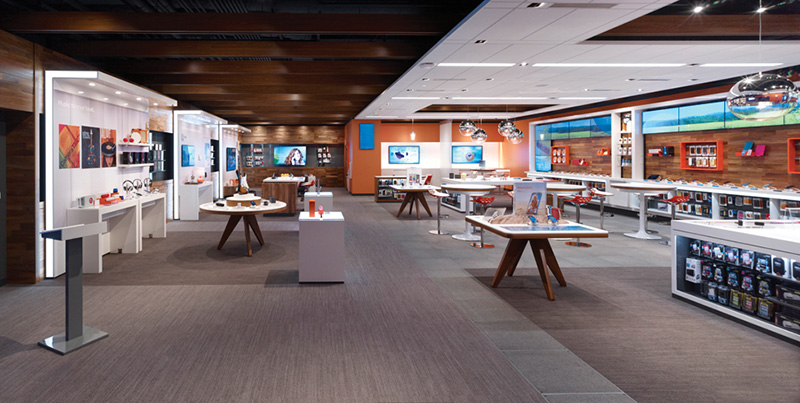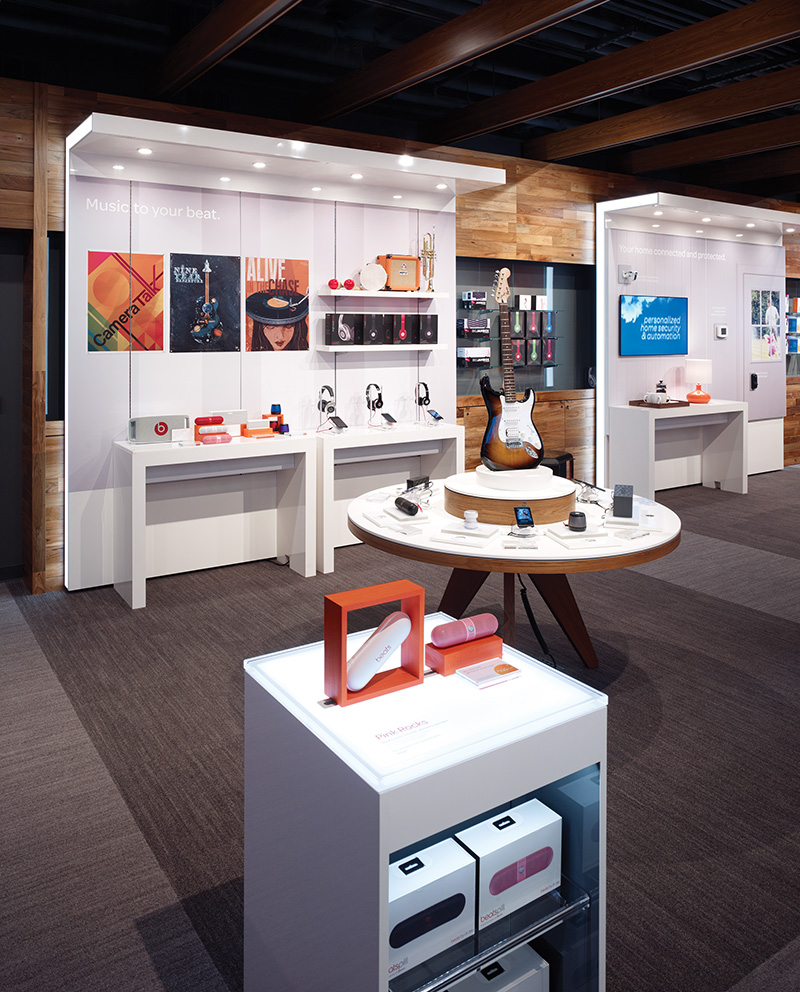With a new ‘Store of the Future’ design, AT&T continues to grow and evolve from every angle of the retailing experience.
By Katie Lee
When it comes to their product lines, technology retailers are accustomed to staying “ahead of the curve” and “two steps ahead” in a fast-moving industry. Keeping pace with the latest, greatest smartphone or tablet is a given — but what about how those products are presented to the customer, or how the customer is able to interact with the devices? Or how store representatives interact with the customer, and how transactions take place? AT&T’s director of store design, Lourdes Burson, recently spoke to Retail Facility Business about the Dallas-based retailer’s new ‘Store of the Future’ — a bold, innovative step into the future of retail design, one that is leaps and bounds ahead of the proverbial curve.
The journey began in fall 2010 as AT&T began to reevaluate its retail format, which is something it does approximately every 5 years. As usual, new design ideas were volleyed about, but then something special happened. Burson and her team, along with AT&T’s longtime architectural partner, Seattle-based Callison, began laying the groundwork for what would become AT&T’s ‘Store of the Future.’
Around the same time, AT&T’s award-winning flagship store on Michigan Avenue in Chicago was undergoing a major makeover. Some of the new ways in which products were presented, changes to the customer interaction experience, and other experiential elements incorporated into that store were later used and improved upon for Store of the Future. The refreshed Michigan Avenue store, which was certified LEED Platinum, opened in September 2012, about 10 months prior to the first Store of the Future opening in Atlanta.
“By the time we opened our first store in Atlanta in 2013, we’d already gained some really great knowledge,” Burson says. “We knew that customers wanted a familiar and inviting environment. We knew that we were on the right course in terms of how we represented the brand, and that that environment needed to tie into that warm and inviting experience — so that changed our color palette, the tonality and the materials that we used. We also wanted to have sustainable elements; those are very important in today’s day and age. But at the same time, make sure the customer knew we were more than a phone store. We wanted to separate ourselves from that historical retail reference of wireless mobile companies, when you think of their retail environment.”
 The Store of the Future design, which is currently featured in 67 AT&T stores nationwide, is built around three zones: the Connected Experience Zone, the Community Zone and the Explore Zone. Connected Experience is where AT&T’s home, security and automation service, AT&T Digital Life, is featured, as well as its TV service, AT&T Uverse. It’s an immersive, experiential and — dare we say — connected area that, according to Burson, is the most unique aspect of the store. Next is the Community Zone, in the store’s center, where the core customer interaction takes place. All sales transactions are completed via a mobilized point-of-sale system, using tablets instead of traditional cash registers. Representatives can sit side by side with customers and walk them through the features of any device. Third, there is the Explore Zone, which most resembles an archetypal ‘phone store,’ featuring a more traditional wall display of AT&T’s core devices.
The Store of the Future design, which is currently featured in 67 AT&T stores nationwide, is built around three zones: the Connected Experience Zone, the Community Zone and the Explore Zone. Connected Experience is where AT&T’s home, security and automation service, AT&T Digital Life, is featured, as well as its TV service, AT&T Uverse. It’s an immersive, experiential and — dare we say — connected area that, according to Burson, is the most unique aspect of the store. Next is the Community Zone, in the store’s center, where the core customer interaction takes place. All sales transactions are completed via a mobilized point-of-sale system, using tablets instead of traditional cash registers. Representatives can sit side by side with customers and walk them through the features of any device. Third, there is the Explore Zone, which most resembles an archetypal ‘phone store,’ featuring a more traditional wall display of AT&T’s core devices.
The average Store of the Future spans about 4,500 square feet but is flexible enough to fit in 2,000 square feet or larger than 4,500. From a daily operations standpoint, the new design has been well received by AT&T employees. “We’ve mobilized the environment; the reps are not tethered to a point of sale register,” Burson explains. “They can help their customers anywhere in the store, no matter what the interaction is. You go wherever you need to go. We’ve given them the tools to be able to do that.”
Another improved aspect of Store of the Future is the way devices are secured on display, which enhances security from a loss prevention standpoint but also increases ease of movement when it comes time to reset a display. “It’s very easy for them to move products around; they don’t have to completely disassemble everything,” Burson says. “They can easily unclick a device off a base and move it to another base without totally dismantling the whole display. The wire management, too, throughout all the fixtures is easily accessible and able to accommodate all the power adapters. Little things like that make a big difference.
 “We’ve also created more areas on the sales floor for them to store inventory so that they don’t have to constantly leave their customers and go into the back of the house to find inventory,” Burson continues. “There’s cabinetry under the displays. They’re not obvious to the customer, but for our team it makes things much simpler.”
“We’ve also created more areas on the sales floor for them to store inventory so that they don’t have to constantly leave their customers and go into the back of the house to find inventory,” Burson continues. “There’s cabinetry under the displays. They’re not obvious to the customer, but for our team it makes things much simpler.”
Another plus for employees is the seating. “This idea of being able to sit down side by side with a customer was a great notion,” Burson says. “Sitting down creates a totally different shopping experience — that personal touch, and interaction that focuses solely on that customer. The ‘learning’ tables help us give our customers our undivided attention. I think that was a huge difference to our team — as opposed to the traditional point-of-sale where the customer’s on one side and the representative is on the opposite side, which lended itself to a barrier between them. The side-by-side interaction is much more personal.”
From a maintenance perspective, the new Store of the Future design has different needs from its predecessor. For example, all lighting has been upgraded to LED, giving the bulbs a substantially longer life and reducing the need for maintenance. All finishes are solid-surface finishes, which are easy to clean by the employees, not just the janitorial service. Previous designs incorporated carpet or wood floors; today’s design features a raised concrete tile floor.
“Retail flooring can take a lot of wear and tear, and sometimes carpet doesn’t always hold up,” says Burson. “With the combination of different types of flooring treatment, our anticipation is that that will have longer shelf life before it needs to have maintenance. Obviously it needs to be cleaned and taken care of at regular intervals, but maybe not to the degree that we had been used to.”
AT&T has in-house support that manages all of the facilities maintenance requests that come into each corporate-owned store. (There are more than 2,000 corporate-owned AT&T stores and more than 3,000 authorized dealer locations.) An outsourced janitorial service is used at regular intervals to support in-house service at the store level in company-owned stores.
From store layout and customer interaction to operations and maintenance, AT&T continues to grow and evolve from every angle of the retailing experience. In 2015, AT&T will continue opening new stores and retrofitting its current fleet to the Store of the Future design.
“This is a really fast-moving industry and our [store design] team has come to be expected to be able to move at a very quick pace — and to deliver flawless execution,” Burson says. “That’s an ongoing goal of my team no matter what we might happen to be working on. What we do is seen from the highest level of the organization to every customer that walks into that store — we are AT&T to that customer.”
— Email the editor at [email protected]. This article originally appeared on the cover of the February/March 2015 issue of Retail Facility Business magazine.
